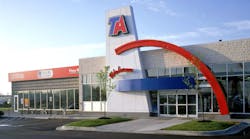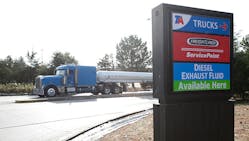Karen Piccolomini will tell you that truck stop chain TravelCenters of America (TA-Petro) always provided road side assistance to truckers suffering break downs on the highway, but didn’t do so in what she termed an “organized” fashion until about 12 years ago when she helped form the company’s RoadSquad roadside service operation.
Today as director of RoadSquad & RoadSquad Connect, Piccolomini said that many of the most common breakdown issues where heavy trucks are concerned remain the same, though with the rapid “computerization” of Class 8 equipment over the years – especially where exhaust emission control systems are concerned – more and more electronic-related problems are on the rise.
Fleet Owner got a chance to talk with Piccolomini about those and other roadside repair details to get a sense of what trends the trucking industry might be facing in this area in the near future – and how TA-Petro’s pool of 3,000 technicians uses its fleet of 500 RoadSquad service vehicles to help trucks stuck on the side of the highway.
What are the most common heavy truck roadside service issues your technicians deal with on a reoccurring basis?
Piccolomini: In order, it’s tires, jump starts/electrical issues, air leaks, out-of-fuel situations – and that includes out-of-DEF [diesel exhaust fluid] as well – and sensor issues. We’ve been watching sensor issues over the years and it keeps moving up the list simple because there are more and more electronically-controlled systems on today’s trucks. We’re also expanding more into trailer service especially due to CSA [The Federal Motor Carrier Safety Administration’s (FMCSA) Comprehensive Safety Accountability program] rules regarding trailer lights. Do you really want to take the risk [of a CSA violation] by driving on the road with a burned out trailer light?
Why do tires remain the top roadside service issue?
Piccolomini: It’s not a surprise when you see that 40% to 50% of our road calls in the middle of August are due to tire failures; heat is just brutal on tires. But in the winter we still get a lot of tire issues because cold temperatures affect inflation levels. Every gain or loss of 10 degrees Fahrenheit in temperature affects tire air inflation levels by 2 psi [pounds per square inch] and I’m still not sure everyone is aware of that. So if when a cold snap arrives and the temperature drops 20 degrees, you may be losing tire pressure of 4 to 6 psi and you don’t even know it. That’s why you’ve got to be diligent in checking inflation levels regularly on all of your tires, even in winter. Add to that the impacts on tires from too-low tread depth and “curbing.” That’s why tires remain our top issue.
It’s interesting that “out of fuel” incidents remain such a prevalent problem for your organization to deal with. Why?
Piccolomini: We still see it because many fleets often maintain very rigorous fuel stop networks. We’ve even had to rescue trucks that’ve run out fuel 5 miles past a refueling location; but it was a location they were not allowed to refuel at. Revisiting the rules/guidelines on refueling we think will help fleets minimize such situations. Out of fuels also just used to just mean a need for diesel, but now DEF needs at the roadside are involved too.Talk about how the demand for roadside services is changing: what’s more in demand than five years ago?
One big change over the last five years has been the need for roadside diagnostics to address the fault codes and service requirements of newer trucks. TA Truck Service RoadSquad technicians are trained on diagnostics and all service trucks are equipped with diagnostic equipment. It is difficult to tell if overall roadside demand is increasing due to a number of factors from the age of the truck or to industry participation. But we make sure our technicians are trained to handle almost anything that happens that causes a road call, and our [RoadSquad] service trucks are outfitted and equipped to meet those demands, based on the kinds of roadside incidents we encounter, because we want to avoid an unnecessary tow for a customer or the need for a second service provider.
How do you organize your road-side service operation to help get trucks in trouble back up and running?
Piccolomini: First our TA-Petro locations are positioned along interstates and highways, making for quick and easy access to the arteries that will quickly get us to a roadside breakdown. This is one aspect that, in certain locations, differentiates a truck stop from a truck dealer. We also support this [roadside service] business with a dedicated 24/7 dispatch center that is tied in real-time to all aspects of field work. This includes full knowledge of all repair activity at each location, technician certification levels, technician schedules, truck availability, and the list goes on. That way, when a driver calls out center, we can get a more accurate picture of what is going on so we can provide the technician being sent out with a fuller picture of the problem. We also now use the Ford F-350 transit as our repair truck platform. It is a perfect match to meet our safety requirements and the demands of our repair services. We have worked with the same outfitter for decades to create engineering solutions that will allow our techs to execute an efficient and safe repair. For example, we spec a start-all/compressor system with large air capacity on each truck – no one wants to wait while a compressor unit builds air. Our trucks are also equipped with everything from jack stands and impact wrenches to ladders for trailer repairs. We also analyze road call data to keep techs knowledgeable about high volume repairs, which also allows us to develop road call kits with the right parts and tools required for the most frequent repairs we’re seeing.Finally, what makes for a great roadside technician? You note many of TA-Petro’s 3,000 technicians are qualified to handle roadside calls. What skills/attitudes do they need that isn’t required in the shop?
Piccolomini: A truck technician’s job is difficult all the way around and always consists of demanding work. A roadside repair increases the level of difficulty, though, and when you factor in safety needs and time-urgency, that requires a unique individual. Let’s elaborate on the safety aspect first. A roadside repair requires extreme safety awareness and diligence and can become more difficult roadside due to the pitch and location of the truck as well as the surface the truck is on. Add in weather factors such as rain, excessive heat or cold, snow and darkness and you need a technician that has the skill set to complete the repair but also fortitude and a more focused safety mindset as well. A roadside repair is an unplanned maintenance event which means the truck driver now is under duress for the load he or she is moving – and unplanned downtime to a driver is a real impact to their livelihood, so getting them up and running fast is critically important. So a technician must fully understand this aspect of the trucking industry and have the attitude and skill set to affect the quickest repair possible. The technicians for our roadside program are selected directly by their management team. This program ensures that a technician is dedicated to road calls and ready, not just with the correct skill level to handle roadside services, but also with the correct safety training and industry awareness of today’s driver challenges. Finally, they really need what I call a “competitive streak” for roadside work; they are competing against themselves in a way. If there’s an unexpected glitch, they take it personally – they want to beat it to prove they are the best. Their name is on that repair. I’ve got nothing but great respect for anyone that can go in and perform to that level.






